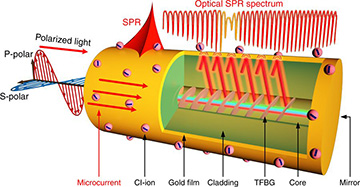In the setup of a research team from China’s Jinan University and Canada’s Carleton University and National Research Council, surface plasmon resonance changes in a gold-coated optical fiber embedded in a supercapacitor are used to monitor the supercapacitor’s charge state. The system could allow real-time monitoring of the charge state of important power-storage devices in renewable-energy systems. [Image: Light Sci. Appl. 7, article 34 (2018); doi: 10.1038/s41377-018-0040-y] [Enlarge image]
The drive toward renewable-energy technologies, such as wind and solar, to help fight climate change puts a premium on ways to store and deliver power from these non-continuous energy sources. One intriguing piece in this power-management puzzle lies in supercapacitors—ultra-high-capacitance structures that can sop up, store and deliver significant amounts of charge, and that can withstand hundreds of thousands of charge-discharge cycles. But how can these closed devices be monitored in real time, to ensure that they’re working at peak efficiency and to prevent potentially catastrophic failures in the renewable-power grid?
Researchers in China and Canada believe that they’ve come up with an answer (Light Sci. Appl., doi: 10.1038/s41377-018-0040-y). By embedding a gold-coated length of optical fiber in the supercapacitor, the team has found that it can monitor the charge state of supercapacitors via resonance changes as light is pumped through the fiber. While thus far the technique has been limited to a lab demo, the team believes that it should scale up well to supercapacitors in real renewable-energy systems. Thus, the gold-coated fiber approach could offer a real-time window for monitoring energy storage and regulating the power supply in those systems.
Exploiting EC-SPR
Supercapacitors and other electrochemical energy storage devices have already found use in a wide variety of clean-energy systems, at scales ranging from mobile medical devices to electric cars to power plants. But as supercapacitor-based storage becomes more and more common, monitoring the working state of these systems is apt to emerge as an increasing headache. Right now, assessing the charge state of a supercapacitor typically involves taking the capacitor offline to perform electrical measurements and simulations—or even popping open the supercapacitor to peer at it with an electron microscope.
The research team in the new work, led by Wenjie Mai and OSA Senior Member Tuan Guo of Jinan University, China, and including scientists from Jinan and from Carleton University and the National Research Council of Canada, saw an opportunity to exploit another method for monitoring supercapacitors: electrochemical surface plasmon resonance (EC-SPR).
When light strikes the interface between a metal and a dielectric, part of the light beam’s energy is transferred into a subwavelength-scale electromagnetic surface wave in a phenomenon known as surface plasmon resonance (SPR). It turns out that the characteristics of the resonance are highly sensitive to chemical or physical changes at the metal-dielectric boundary. That’s because the bonding of chemical substances on the metal surface changes the local refractive index and, thus, the phase velocity and attenuation distance of the SPR. (Indeed, this principle has long been used in biosensing applications.)
Building a fiber probe
To take advantage of EC-SPR for keeping tabs on supercapacitors, the Chinese-Canadian team devised a probe consisting of a commercial, telecom-grade single-mode optical fiber, with a tilted fiber Bragg grating imprinted in its core and with a nanometers-thick coating of gold around the fiber’s outer layer. They then embedded the sensor in one electrode of a two-plate capacitor, and pushed broadband polarized light (1250-1650 nm) through the fiber while the capacitor was running. An optical spectrum analyzer at the end of the chain allowed changes in the surface resonance to be measured.
As polarized light shines through the fiber, the 18-degree-tilted Bragg grating couples the light to the external gold cladding, creating the plasmon resonance at the surface, which in turn is in contact with electrolyte ions in the capacitor (see the diagram above). The team found that, as the charge density and ion distribution in the supercapacitor changed, those changes could be read directly in variations in the optical SPR spectrum—revealing “a stable and reproducible correlation between the real-time charge–discharge cycles of the supercapacitors and the optical transmission of the optical fiber.” And that correlation remained solid over a number of charge-discharge cycles.
Filling a renewable-energy gap?
The researchers believe that the EC-SPR approach offers “a unique, low-cost method for real-time monitoring of energy storage devices in operation,” according to a press release that accompanied the work. The team points out in particular that the device is compact (around 30 mm long and 125 microns in diameter) and is based on tweaks to a commonplace telecom technology. That could, in the view of the paper’s authors, make the technique a robust and cost-effective candidate to help keep an eye on the charge state of supercapacitors—and, perhaps, to fill a small but important gap in the renewable-energy picture.

